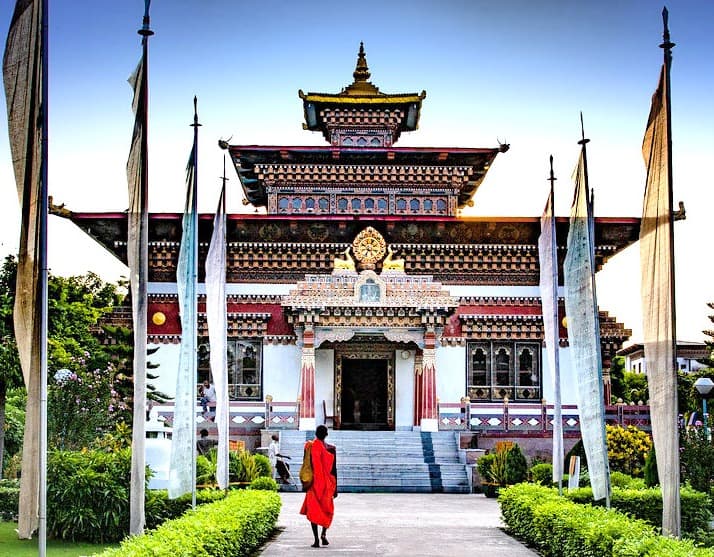Discover the Top 10 Reasons to Visit Bhutan, a kingdom where ancient culture, spiritual sanctity, and pristine landscapes blend to create a unique travel experience. Bhutan, the Land of the Thunder Dragon, offers a haven for nature lovers, spiritual seekers, and cultural enthusiasts alike. This guide delves into the best attractions in Bhutan, from the iconic Tiger's Nest Monastery to the vibrant local festivals and rich Bhutanese cuisine. Whether you're looking to explore the unspoiled natural beauty, understand the philosophy of Gross National Happiness, or undertake epic trekking tours, Bhutan provides an exclusive and enriching journey unlike any other. Here, Bhutan's travel guide helps unveil the magic of this hidden Himalayan gem, highlighting why it stands out as a must-visit destination on every traveler's list.
At Druk Holidays, we pride ourselves on being your premier guide to discovering the Top 10 Reasons to Visit Bhutan. As experts in Bhutanese travel, we ensure that each journey with us is not just a trip, but a deep dive into the heart of the Himalayas. From the awe-inspiring Tiger's Nest Monastery to the lively and colorful local festivals, and the unique flavors of Bhutanese cuisine, our tailored itineraries are designed to showcase the very best attractions in Bhutan. Experience the natural beauty, cultural richness, and spiritual depth of Bhutan with us. Our dedication to providing exclusive and enriching experiences makes Druk Holidays the best choice for those seeking to explore the authentic and untouched corners of Bhutan. Let us show you why Bhutan is a treasure trove of experiences, with each visit contributing to personal growth and happiness, guided by the country’s innovative philosophy of Gross National Happiness.
Pristine Landscapes
Bhutan's landscapes are a pristine sanctuary where nature's best elements are preserved and revered. From the dense forests that blanket the slopes of rolling hills to the crystal-clear rivers that cut through the valleys, Bhutan offers a canvas of natural wonders that remain untouched by modern encroachments. Here, every view is a window into the harmonious balance between nature and the people who cherish it deeply.
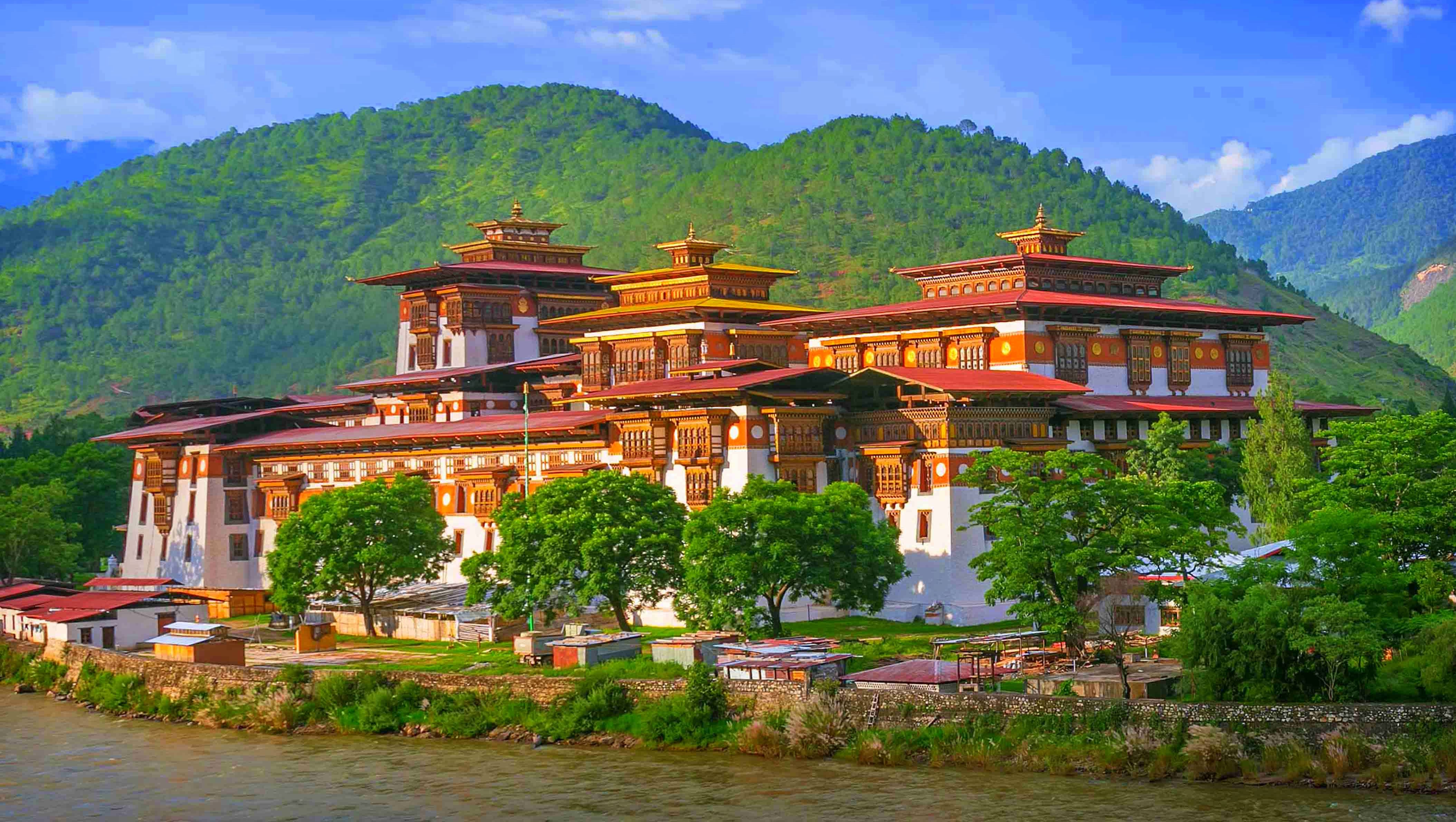
- Himalayan Panorama: The majestic Himalayas frame the northern skies of Bhutan, offering awe-inspiring views that are both serene and spectacular.
- Verdant Valleys: Lush green valleys such as Paro, Punakha, and Bumthang are fertile and rich, supporting diverse ecosystems and traditional farming practices.
- Untouched Wilderness: Large swathes of Bhutan are designated as national parks and protected areas, safeguarding biodiversity and providing sanctuaries for wildlife.
- Flowing Rivers: The crystal waters of the Mo Chhu, Paro Chhu, and other rivers are lifelines of the landscape, supporting agriculture and revered as sacred spaces.
- High-Altitude Lakes: Remote and mystical, lakes like Phobjikha and Gasa are nestled high in the mountains, offering tranquil retreats and stunning natural beauty.
- Floral and Faunal Diversity: Bhutan is a hotspot for botanical and zoological diversity, with numerous species of plants, birds, and mammals that are endemic to the region.
- Mountain Passes: Traveling through mountain passes such as Chele La and Thrumshing La provides breathtaking panoramic views and encounters with nomadic herders.
- Rural Landscapes: The rural heartlands of Bhutan are dotted with traditional Bhutanese farmhouses and medieval villages, presenting a picturesque view of country life.
Bhutan’s landscapes are not just a testament to the natural beauty of the Himalayas but also a reflection of the nation's commitment to conservation and sustainable living. These pristine environments offer more than just visual delight; they provide a soulful journey back to nature’s fundamental elements, making every visit a profound experience in discovering the untouched and preserved beauty of the world.
Cultural Richness
Bhutan's cultural richness is deeply embedded in its people, traditions, and the national ethos that values spiritual and cultural preservation above all else. This Himalayan kingdom has maintained a vibrant cultural heritage that is both ancient and alive today, offering a fascinating glimpse into a society where traditional customs are a daily way of life.
- Traditional Dress: The Bhutanese people proudly wear their national dress, the Gho for men and Kira for women, as standard attire, showcasing their cultural identity.
- Language and Literature: Dzongkha, the national language, is taught in schools and used in official settings, preserving the linguistic heritage. Bhutanese literature, rich in folklore and religious texts, continues to influence the cultural landscape.
- Spiritual Practices: Buddhism permeates every aspect of Bhutanese life, with prayer flags, chortens, and monasteries dotting the landscape, each serving as a focal point for communal and spiritual gatherings.
- Arts and Crafts: Known as the thirteen arts (Zorig Chusum), traditional crafts such as thangka painting, sculpture, and weaving are not only art forms but also spiritual practices that have been passed down through generations.
- Festivals: The Tshechus and other religious festivals are central to Bhutanese life, featuring mask dances, music, and rituals that draw participants from all over the country, reinforcing community bonds and cultural pride.
- Architecture: Bhutanese architecture is distinctive, with fortress-like dzongs and beautifully decorated houses that incorporate traditional designs without using nails or iron bars.
- Music and Dance: Traditional music and dances are integral to festivals and royal celebrations, often telling stories of the spiritual history of Bhutan or celebrating seasonal changes.
- Culinary Traditions: The Bhutanese cuisine, with its notable use of chilies and cheese, offers a unique culinary experience that is both bold and simple, reflecting the agricultural practices and natural resources available.
Bhutan's commitment to cultural preservation is evident in every aspect of its society, from government policies to everyday activities. This dedication not only safeguards Bhutan's ancient traditions but also offers a vibrant, living culture that visitors can experience and appreciate. The kingdom’s cultural richness is a colorful tapestry that weaves together the past and present, creating a unique and enduring national identity.
Gross National Happiness
Bhutan's innovative concept of Gross National Happiness (GNH) transcends the traditional measures of national success, focusing instead on holistic and sustainable development. Introduced by the fourth King of Bhutan, this philosophy is integral to government policy and reflects a commitment to preserving the spiritual, cultural, social, and environmental pillars of Bhutanese society.
- Holistic Development: GNH is a multi-dimensional development approach that values collective happiness as the primary goal of governance, influencing all aspects of national policy from education to environmental conservation.
- Environmental Conservation: One of the pillars of GNH is environmental sustainability. Bhutan is the world's only carbon-negative country, emphasizing the importance of nature and ecological protection in contributing to national happiness.
- Cultural Preservation: GNH stresses the importance of cultural heritage as a source of identity and continuity, leading to strong policies that support the preservation of Bhutan's unique traditions and customs.
- Sustainable Socio-Economic Development: Economic policies under GNH are designed to ensure equitable distribution of wealth and to promote sustainability, ensuring that economic growth does not compromise the cultural and environmental assets of the nation.
- Good Governance: Transparency, accountability, and participation are key components of GNH, reflecting the belief that good governance is essential for the happiness of the populace.
- Community Vitality: Strong community interactions and social gatherings are encouraged in Bhutan, enhancing social support systems and communal bonds, which are vital for societal well-being.
- Mental Wellbeing: Mental health is recognized as just as important as physical health in the GNH philosophy, with programs and policies in place to address mental wellness across all age groups.
- Health and Education: The government invests heavily in public health and education, with the understanding that access to quality healthcare and education are fundamental to happiness and well-being.
Gross National Happiness in Bhutan is not merely a policy but a way of life that influences every aspect of Bhutanese society. It is a visionary philosophy that seeks to balance material well-being with spiritual, emotional, and cultural wealth. This approach has positioned Bhutan as a global leader in sustainable development and wellbeing, offering a profound example for the rest of the world on prioritizing human happiness and environmental health over mere economic growth.
Architectural Wonders of Bhutan
Bhutan's architectural heritage is a vivid expression of the kingdom's deep spiritual roots and historical richness. The unique design principles behind Bhutanese architecture do not merely aim for aesthetic appeal but also embody the spiritual and cultural ethos of the country. Here are some of the Architectural Wonders that make Bhutan a remarkable destination.
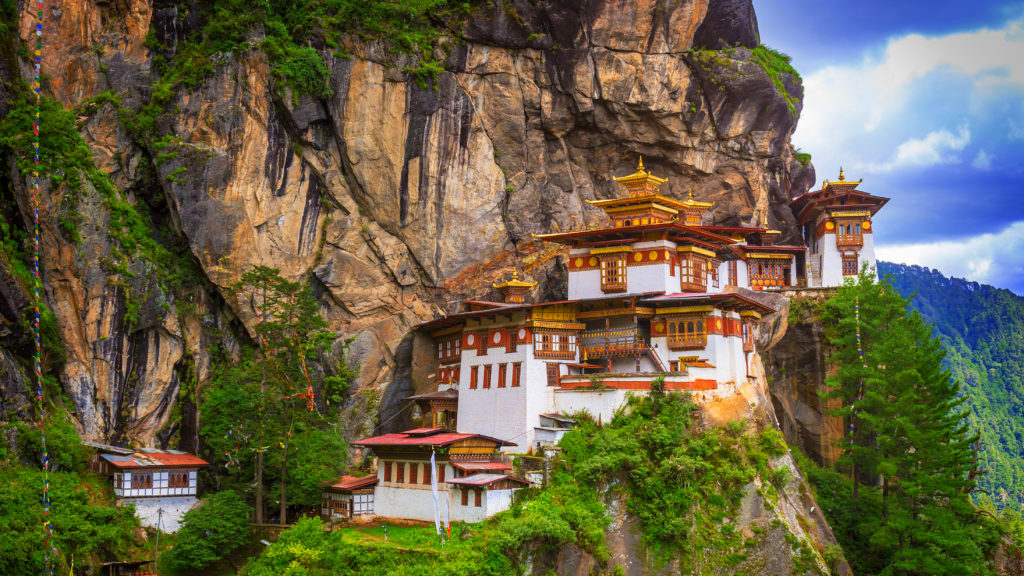
- Dzongs: These fortress-like structures serve both religious and administrative purposes and are central to Bhutanese culture. Famous dzongs like Punakha Dzong and Paro Dzong showcase intricate woodwork and beautiful frescoes that reflect the Bhutanese architectural genius.
- Monasteries: Bhutan's landscape is dotted with monasteries that are not only places of worship but also architectural marvels. The Tiger's Nest Monastery (Paro Taktsang), precariously perched on a cliff face, is perhaps the most iconic example.
- Traditional Houses: Constructed with mud walls and wooden frames, traditional Bhutanese houses are built without the use of a single nail. Their colorful window frames and intricately painted exteriors are a common sight throughout the countryside.
- Bridges: The traditional cantilever bridges in Bhutan are an architectural feature that combines functionality with aesthetic design, often adorned with prayer flags that add a spiritual dimension to their structure.
- Chortens (Stupas): These religious monuments are significant in Buddhist architecture, symbolizing the mind of Buddha. They are found throughout Bhutan and are revered as sacred structures.
- Palaces: Although fewer in number, royal palaces like the Dechencholing Palace stand as exquisite examples of royal Bhutanese architecture, combining both traditional Bhutanese and modern designs.
- Public Buildings: Even modern public buildings in Bhutan adhere to traditional architectural styles, ensuring that contemporary constructions blend harmoniously with the historic and natural environment.
- Religious Pavilions and Prayer Wheels: Small pavilions and prayer wheels, which are found along roads and paths throughout Bhutan, reflect the integration of spiritual practices and architectural elements in daily life.
The Architectural Wonders of Bhutan are a testament to the nation's dedication to preserving its cultural identity while adapting to the needs of the modern world. Each structure tells a story of the past, celebrates the present, and holds the spiritual essence that is quintessentially Bhutanese. This architectural heritage not only adds to the visual beauty of the landscape but also enriches the cultural fabric of the country.
Vibrant Festivals
The vibrant festivals of Bhutan are a spectacular expression of its cultural and spiritual richness, drawing visitors from around the world. These festivals, or Tshechus, held in various dzongs and monasteries across the country, are not just religious ceremonies but also social gatherings that reinforce the bonds of community and culture.

- Tshechu Festivals: These are the most prominent festivals in Bhutan, celebrated in honor of Guru Rinpoche, who brought Buddhism to Bhutan. Each district hosts its own Tshechu, featuring days of dancing, music, and religious enactments.
- Paro Tshechu: One of the most famous Tshechus, held in the Paro Dzong, this festival is known for the unfurling of the giant Thongdrel (a large tapestry) of Guru Rinpoche, which is believed to cleanse onlookers of their sins.
- Thimphu Tshechu: As the capital city, Thimphu's Tshechu is one of the biggest and most vibrant, attracting the largest audiences, including the royal family. Highlights include the mask dances and the Atsara (clown) performances, which blend humor with spiritual teachings.
- Jambay Lhakhang Drup: This festival is famous for the 'Mewang' (Fire Ceremony) and the 'Tercham' (Naked Dance), performed at midnight. The dance, performed by masked dancers, is a highlight and is said to confer blessings on the onlookers.
- Punakha Drubchen and Tshechu: Celebrating the 17th-century military victory by Bhutanese forces over Tibetan invaders, this festival includes a dramatic recreation of the battle scene, making it a unique cultural and historical spectacle.
- Haa Summer Festival: A newer addition to Bhutan’s festival scene, the Haa Summer Festival showcases the lifestyle and unique traditions of the nomadic herders of Haa Valley, including yak riding and local cuisine.
- Black-Necked Crane Festival: Held in the beautiful Phobjikha Valley, this festival celebrates the arrival of the endangered Black-Necked Cranes. It includes cultural programs, songs, and dances performed by local school children and community members.
- The Mask Dances: Central to these festivals are the Cham dances, where monks and laymen wear elaborate costumes and masks depicting deities, demons, and animals, performing narratives that teach moral lessons and depict historical events.
These Vibrant Festivals of Bhutan offer a window into the soul of Bhutanese life, embodying the spiritual depth and communal harmony of this Himalayan kingdom. Each festival is a vivid tapestry of history, culture, and religion that continues to thrive and attract cultural aficionados from all over the globe.
Trekking Adventures
Bhutan, with its dramatic landscapes and unspoiled wilderness, offers some of the most rewarding trekking adventures in the world. The rugged Himalayan terrain provides not just a challenge for avid trekkers but also an opportunity to experience the pristine beauty and remote cultures of the kingdom. Here’s a guide to the top trekking adventures that Bhutan has to offer.
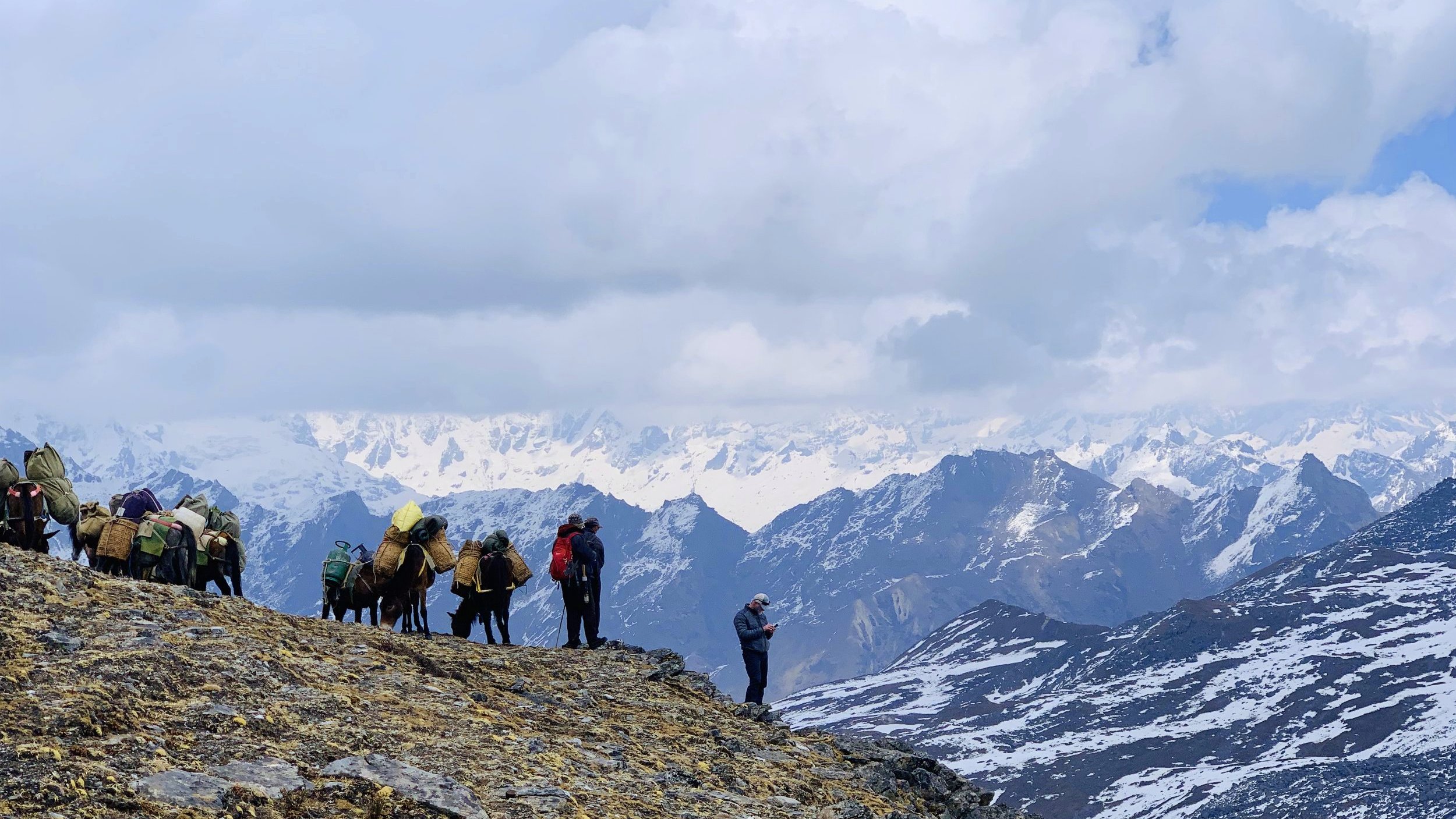
- Snowman Trek: Renowned as one of the most challenging treks in the world, the Snowman Trek traverses through 11 high passes over 4,500 meters, offering spectacular views of the Himalayas and remote villages.
- Jomolhari Trek: This popular route provides stunning views of Mount Jomolhari, Bhutan’s sacred mountain. The trek passes through thick pine forests, high alpine meadows, and traditional Bhutanese villages.
- Druk Path Trek: Connecting the valleys of Paro and Thimphu, this relatively short trek is ideal for those looking to experience Bhutan’s stunning, varied landscapes without the commitment to more extended periods in the wilderness.
- Laya Gasa Trek: Extending from the picturesque landscapes of Paro to the remote Laya region, trekkers on this route encounter unique culture, hot springs, and the chance to see the rare Takin, Bhutan’s national animal.
- Bumthang Cultural Trek: This trek offers a unique blend of natural beauty and exposure to the religious and cultural heritage of the kingdom, passing through several ancient monasteries and traditional Bhutanese villages.
- Dagala Thousand Lakes Trek: As the name suggests, this trek showcases some of the most beautiful high-altitude lakes in Bhutan, along with stunning views of the entire Himalayan range and Bhutan’s highest peaks.
- Merak Sakteng Trek: This trek explores the semi-nomadic lifestyle of the Brokpa people in the easternmost parts of Bhutan, featuring unique cultural insights and untouched natural beauty.
- Gangtey Trek: A relatively easy trek that offers a beautiful journey through the glacial valleys of Phobjikha, this route is also known for its stunning scenery and the winter home of the black-necked cranes.
Trekking in Bhutan is not just a physical journey but also a spiritual and cultural adventure, offering glimpses into the kingdom’s soul. Each path leads to an understanding of why Bhutan holds the title of the last Shangri-La, with its commitment to conservation, cultural preservation, and sustainable travel practices. These trekking adventures offer a profoundly personal connection to the heart of the Himalayas, promising memories that last a lifetime.
Sustainable Travel
Bhutan's approach to Sustainable Travel is deeply rooted in its national philosophy of Gross National Happiness, which prioritizes environmental conservation, cultural preservation, and sustainable development. This approach has made Bhutan an exemplar in sustainable tourism practices, offering visitors a chance to experience travel that is responsible and enriching while minimizing its impact on the environment and local communities.
- Controlled Visitor Numbers: Bhutan limits the number of tourists through a daily tariff and mandatory guide policies, ensuring that tourism remains sustainable and benefits the economy without overwhelming local resources and culture.
- Eco-Friendly Policies: The government mandates that a significant portion of the country must remain forested, and the use of plastic bags is banned. Such policies help maintain the country’s status as the world’s only carbon-negative country.
- Community-Based Tourism: Many tourism initiatives are community-led, ensuring that the benefits of tourism are directly felt by local populations. This includes homestays, community-guided tours, and locally run restaurants.
- Preservation of Sites: Tourist sites, especially those of cultural and historical significance, are meticulously maintained. Funds from tourism tariffs contribute to the restoration and preservation of these sites, helping ensure they endure for future generations.
- Promotion of Local Culture: Tourists are encouraged to engage with and learn from the local culture, including wearing traditional dress and participating in local festivals, fostering a greater appreciation and respect for Bhutanese traditions.
- Education and Awareness: Visitors are educated about the local customs, traditions, and environmental issues, promoting responsible behavior that aligns with the values of conservation and respect for local customs.
- Sustainable Infrastructure: Development in Bhutan, including tourism infrastructure, is designed to be sustainable, often using local materials and traditional methods that blend with the landscape and support ecological balance.
- Support for Green Businesses: The Bhutanese government supports and promotes businesses that adopt green practices, including organic farming, renewable energy, and waste reduction, further reinforcing the country's commitment to sustainability.
Sustainable Travel in Bhutan is not just about seeing a new place; it's about immersing oneself in an environment that is cared for and respected by both its people and its visitors. This holistic approach ensures that the beauty, culture, and integrity of Bhutan are preserved, making every visit a positive contribution to the country’s heritage and future.
Unique Cuisine
Bhutan's cuisine is as distinctive as its culture, characterized by its bold flavors and the central role of chilies and cheese. This unique culinary style offers an insight into the Bhutanese way of life, where food is both a staple and a celebration. Here are some highlights of the Unique Cuisine of Bhutan that every visitor should experience.
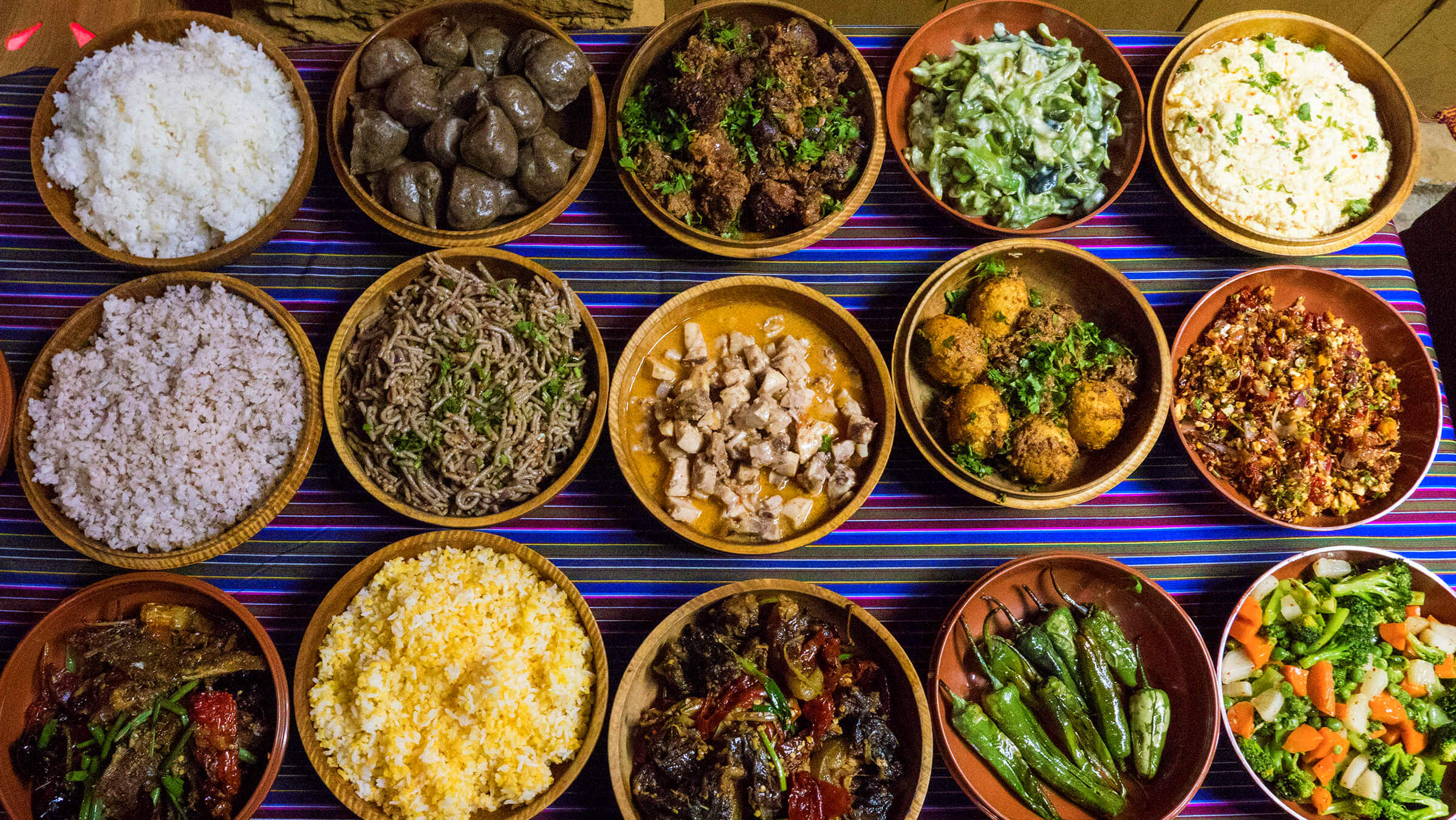
- Ema Datshi: This is the national dish of Bhutan, made from chili peppers and local cheese called Datshi. It comes in various forms, incorporating green, red, or dried chilies, and is a must-try for its creamy, spicy flavor.
- Jasha Maroo: A spicy chicken stew, Jasha Maroo is cooked with ginger, garlic, onions, and sometimes tomatoes, offering a hearty and comforting dish typical of traditional Bhutanese meals.
- Red Rice: Bhutanese red rice is a dietary staple. Grown in the rich mineral soils of the Paro Valley, it has a nutty flavor, is slightly sticky, and pairs perfectly with stews and curries.
- Momos: These Tibetan-style dumplings have been adopted into Bhutanese cuisine with a local twist, filled with pork, beef, or cabbages and cheese, and served steamed or fried.
- Phaksha Paa: Pork cooked with spicy red chilies, radishes, ginger, and bok choy, this dish is a flavorful representation of Bhutan’s love for meat and spice.
- Suja: Butter tea is a Bhutanese favorite, particularly in the colder regions. Made from tea leaves, butter, and salt, it’s an acquired taste that is energizing and believed to be nutritious.
- Ara: A traditional alcoholic beverage made from rice, barley, or maize, Ara is fermented and sometimes distilled, often served during festivities and communal gatherings.
- Lom: A side dish of dried turnip leaves that have been rehydrated and stir-fried with chilies and other vegetables, offering a tangy and spicy flavor.
The Unique Cuisine of Bhutan reflects its agricultural practices, regional variations, and the Bhutanese penchant for spices and dairy. This cuisine is not only a feast for the palate but also an integral part of Bhutan’s cultural identity, offering a delicious gateway to understanding the local way of life and its harmonious relationship with nature.
Warm Hospitality
One of the most enchanting aspects of visiting Bhutan is experiencing the Warm Hospitality of its people. Bhutanese culture deeply values kindness and hospitality, making visitors feel exceptionally welcome. This inherent warmth is a fundamental part of the Bhutanese identity and adds immeasurably to the travel experience in this Himalayan kingdom.
- Homestays: Staying with a Bhutanese family in a homestay is perhaps the best way to experience genuine Bhutanese hospitality. Guests are treated as part of the family, with opportunities to engage in daily life activities, from cooking traditional meals to participating in family rituals.
- Community Interaction: Bhutanese people are known for their friendly and open nature. Visitors often find themselves invited to join local festivities or simply share a cup of tea. Such interactions provide deep insights into the local way of life and create lasting bonds.
- Cultural Respect: The respect that Bhutanese people have for their own culture is extended to visitors. They are eager to share their traditions and history and appreciate when visitors show interest and respect for their way of life.
- Assistance and Guidance: Throughout Bhutan, whether in cities or remote areas, locals are incredibly helpful to travelers, often going out of their way to assist them. From guiding lost tourists to offering unsolicited advice on the best places to visit, their support is constant.
- Festive Welcomes: During festivals, the hospitality is magnified, with visitors welcomed to participate in the celebrations. These occasions are a perfect reflection of the communal spirit and generosity of the Bhutanese people.
- Hospitality in Business: Even in commercial settings such as hotels and restaurants, the service is marked by a personal touch. Staff members often remember returning guests’ preferences and go above and beyond to ensure a comfortable and memorable stay.
- Safety and Security: The sense of being cared for extends to the overall safety and security that visitors feel in Bhutan. The low crime rate and the protective approach of locals contribute greatly to a worry-free visit.
- Guides and Tour Operators: Bhutanese tour guides and operators, with their deep knowledge and professional hospitality, enhance the travel experience. They serve not just as guides but as cultural ambassadors, embodying the warm hospitality that Bhutan is known for.
The Warm Hospitality in Bhutan transcends mere politeness; it is an expression of the country's spirit and a cornerstone of their Gross National Happiness philosophy. For travelers, this welcoming environment transforms a simple visit into a heartfelt connection with a new culture and its people, making every journey to Bhutan a profoundly satisfying experience.
Exclusive Access
Bhutan’s approach to tourism offers Exclusive Access to a world that balances modernity with ancient traditions, sustainability with development, and tourism with preservation. This unique approach ensures that every visit is special, not just for the rarity of the experience but also for the quality and depth it offers to those who journey to this secluded Himalayan kingdom.
- Limited Tourist Numbers: Bhutan maintains its exclusivity by regulating the number of tourists through a minimum daily fee and a visa policy that ensures sustainable tourism. This controlled access helps preserve the natural environment and cultural integrity, providing a serene and uncrowded experience.
- Unique Cultural Insights: Visitors gain special access to some of the most remote and sacred sites in the country, which are less exposed to the broader tourist crowds. This includes exclusive monastery visits, private ceremonies, and village tours that are typically beyond the reach of the average traveler.
- Tailored Itineraries: With the help of local tour operators like Druk Holidays, travelers can experience customized itineraries that are tailored to their interests, whether it’s trekking, cultural tours, or spiritual retreats. This personalized approach ensures an in-depth exploration of Bhutan’s best offerings.
- Special Permits: Certain areas of Bhutan require special permits that restrict access to only a few visitors each year, preserving the natural beauty and cultural significance of these places. This limited access guarantees an intimate experience away from mainstream tourism paths.
- Sustainable Practices: By promoting sustainable practices, Bhutan offers an exclusive opportunity to engage in responsible tourism that contributes positively to the preservation of the kingdom’s environmental and cultural treasures.
- High-Quality Service: The emphasis on quality over quantity in Bhutanese tourism ensures that all services, from accommodation to guided tours, are provided with the highest standard of hospitality and expertise, enhancing the overall travel experience.
- Unspoiled Landscapes: The limited tourist footprint allows for the conservation of Bhutan’s pristine landscapes, providing exclusive access to some of the most untouched and stunning environments in the world.
- Authentic Interactions: The exclusivity of Bhutanese travel also extends to more genuine interactions with local people, who are typically more receptive and engaged due to the low volume of visitors.
Exclusive Access in Bhutan is not merely about limiting the number of visitors but about offering a profoundly meaningful and high-quality experience that respects the natural and cultural ethos of the kingdom. This approach ensures that Bhutan remains a unique destination that offers solitude, beauty, and an unfiltered connection with its heritage and landscapes.
Bhutan offers a unique blend of natural beauty, rich culture, and sustainable practices that make it a must-visit destination for any traveler seeking a deeper connection with both nature and tradition. From the breathtaking Himalayan landscapes and the serene monastic sites to the vibrant local festivals and the distinctive cuisine, Bhutan encapsulates an array of experiences that are both enriching and exclusive. Its commitment to maintaining Gross National Happiness invites visitors into a world where development harmonizes with cultural preservation and environmental sustainability, ensuring each journey to Bhutan is not only memorable but also profoundly meaningful.
FAQs for the Top 10 Reasons to Visit Bhutan
Q: What is the best time of year to visit Bhutan?
A: The best times to visit Bhutan are during the spring (March to May) and autumn (September to November) months. These periods offer pleasant weather, clear skies, and the opportunity to participate in major festivals such as the Paro and Thimphu Tshechus.
Q: Do I need a visa to travel to Bhutan?
A: Yes, all international tourists (except for citizens of India, Bangladesh, and the Maldives) need a visa to enter Bhutan. Visas are processed through a tour operator and are included in the cost of your travel package.
Q: How much does it typically cost to travel to Bhutan?
A: Bhutan has a unique tourism policy known as the Minimum Daily Package Rate which during high season (March, April, May, September, October, and November) is typically around $250 per day per person. This includes accommodation, food, transport, and an official guide.
Q: Are there any specific cultural etiquettes I should be aware of when visiting Bhutan?
A: Yes, Bhutanese culture places a high value on respect and modesty. Dress conservatively, especially when visiting religious sites. Always ask for permission before taking photographs, particularly of people and religious icons.
Q: What are the must-see places in Bhutan?
A: Bhutan offers many incredible sites, but the must-see places include the Tiger's Nest Monastery, Punakha Dzong, the capital city Thimphu, and the beautiful valleys of Paro, Bumthang, and Phobjikha.
Q: What kind of accommodation can I expect in Bhutan?
A: Accommodations in Bhutan vary from luxurious 5-star hotels to cozy guesthouses and traditional homestays. All are regulated to ensure they meet the standards set by the Tourism Council of Bhutan.
Q: Is Bhutan suitable for adventure sports?
A: Absolutely, Bhutan is ideal for adventure enthusiasts, offering activities like trekking, mountain biking, and rafting in some of the most stunning and rugged terrains of the Himalayas.
Q: Can I use my credit cards and foreign currency in Bhutan?
A: Credit cards are increasingly accepted at hotels and other larger businesses in Bhutan. However, it's advisable to carry some cash (in Bhutanese Ngultrum, which is pegged to the Indian Rupee) for smaller purchases and in more remote areas.
Q: What is unique about Bhutanese cuisine?
A: Bhutanese cuisine is known for its spiciness, with chilies considered more of a vegetable than a seasoning. Common dishes include Ema Datshi (chili and cheese stew), red rice, and various meat dishes.
Q: How does Bhutan preserve its culture and environment?
A: Bhutan places great emphasis on cultural and environmental preservation through its Gross National Happiness philosophy, which balances economic development with cultural preservation, environmental sustainability, and good governance.


